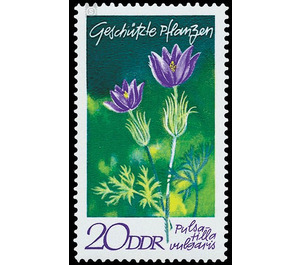Protected native plants - Germany / German Democratic Republic 1970 - 20 Pfennig
Theme: Flora
| Country | Germany / German Democratic Republic |
| Issue Date | 1970 |
| Face Value | 20.00 |
| Color | multi-colored green |
| Perforation | K 14 |
| Printing Type | Photogravure |
| Stamp Type | Postage stamp |
| Item Type | Stamp |
| Chronological Issue Number | 1306 |
| Chronological Chapter | GER-DDR |
| SID | 261607 |
| In 31 Wishlists | |
Protected plants The Ministry of Posts and Telecommunications of the German Democratic Republic publishes six multicolored special postal stamps with images of protected plants. Pulsatilla vulgaris (L.) MILL. (20 pfennig value) The real cowbell belongs to the buttercup family (Ranunculaceae). Its large, bluish blue flowers appear in May in front of the deeply divided leaves. As a dry grass and steppe plant, the species is characterized by an evaporation protection in the form of a dense silky hair. The plant prefers lime-rich soil and occurs in the GDR, especially in the Thuringian districts and the central German dry area (districts Halle, Magdeburg). Their total distribution ranges from southern Central Europe to southern Sweden. The poisonous plant is a relic of a post-glacial steppe vegetation in Central Europe. It reaches in the GDR their eastern distribution limit, which runs approximately from the district of Gera on spice, Havelberg and Templin to Rügen.


